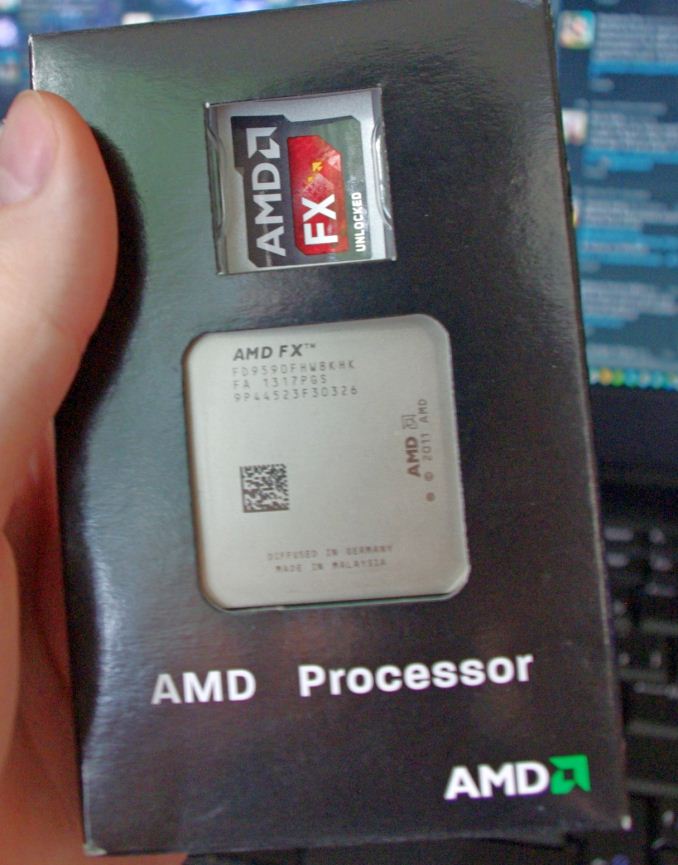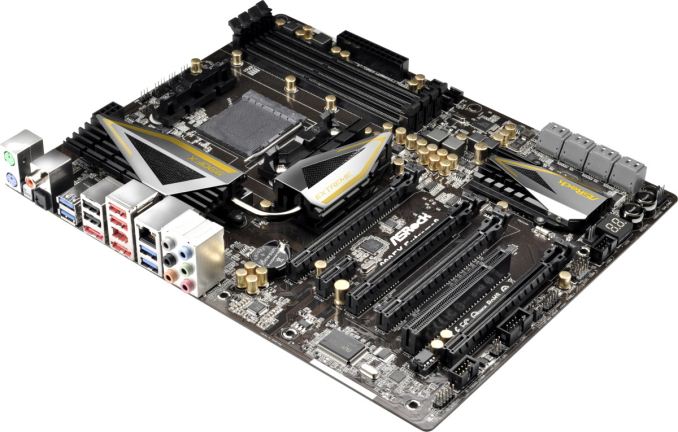AMD’s 5 GHz Turbo CPU in Retail: The FX-9590 and ASRock 990FX Extreme9 Review
by Ian Cutress on August 9, 2014 8:00 AM ESTThe AMD FX-9590
The analysis in this review shows that even a year after the OEM release of the FX-9590, and almost two years from the architecture coming to market it remains AMD’s performance part. If power consumption is not a concern, as a CPU compute and an AMD gaming CPU (especially when considering SLI) the FX-9590 is the best choice at stock speeds. On that basis alone, it makes sense that AMD should actually release it as a retail part, assuming they have enough stock. One might argue that a user could buy an FX-8350 and overclock, but if our sample CPUs were anything to go by, a user needs a fair bit of luck. The FX-9590 guarantees a 5.0 GHz turbo with a warranty.
With the retail release of the CPU, that warranty might be based on using the water cooling provided for the lifetime of the CPU. One might argue that AMD had trouble finding enough dies that could reach the frequencies and voltages for the FX-9590, and hence the delay combined with selling the SKU in select markets only.
The FX-9590 is the same Piledriver architecture as the FX-8350, which in turn was used in the A10-5800K/A10-6800K APUs, codename ‘Trinity’ and ‘Richland’ respectively. Since then, AMD has launched the Steamroller architecture modifications in the form of Kaveri APUs. The difference between a PIledriver APU and a similar frequency Steamroller APU, if we put aside the move from 32nm SOI to 28nm SHP, is around 10% for CPU performance. If that was shifted into a four-module, eight-thread CPU, it would surely be AMD’s performance part. The issue here is that AMD has almost discarded the high CPU performance arena in favor of integrated graphics. From Trinity to Kaveri, the IGP inside those APUs has improved considerably, indicating where AMD is investing its research dollars.
AMD clearly still cares about the performance market, otherwise this retail FX-9590 with water cooling would have never been pushed through to retailers. The high power consumption, the lack of a modern chipset, and the comparison to Intel CPUs in single threaded benchmarks are the main barriers to adoption. If AMD is to return to the performance market, the power consumption has to be comparable to Intel, or if it is slightly higher, the chipset has to offer something Intel cannot. Any suggestions for what that feature should be should be submitted on a postcard/in the comments.
ASRock 990FX Extreme9 Conclusion
One of the big issues surrounding AMD motherboards is their price sensitive nature. With an Intel based product, a $250-$400 motherboard is common enough to signify the expense in research or extra features. Because the AMD ecosystem, even in the high performance segment, is a cost sensitive market there is little room to move. For example, this year sees the first overclocking based motherboard for AMD APUs since the AM3+ era. So at $170, the Extreme9 could arguably be described as ‘limited’ compared to Intel standards.
The motherboard itself has specified support for 220W CPUs, something other motherboards either fail to mention or advise against completely. The native SATA 6 Gbps ports were ahead of Intel at the time, plus ASRock adds in another SATA 6 Gbps controller for good measure.
The eight USB 3.0 ports makes the Extreme9 have more USB 3.0 ports than almost every other 990FX/AM3+ motherboard ever released. This is combined with plenty of legacy support, such as separate PS/2 connectors, a PCI slot, an IEEE1394 port and an IEEE1394 header. The Intel NIC is paired with a Realtek ALC898 codec, with the PCIe layout aimed at 3-way GPU users for both Crossfire and SLI.
Aside from an updated chipset, if we were building a high-end AM3+ motherboard in 2014, I would insist on WiFi support and an upgraded audio codec to the ALC1150 at the minimum. We cannot get around the lack of PCIe 3.0 support, although moving the CPU modules from Piledriver to Steamroller along with the IO support might help with that. If we are being greedy with what we would like, I would add in M.2 support as well.
There is plenty to speculate if AMD had kept updating their high-end performance CPU line, even if the socket was not updated. As it stands, users who want SLI either look back to 990FX or invest in Intel. Users who want high multithreaded CPU performance either look back to 990FX or invest in Intel. Users who do not want processor graphics either look back to 990FX, buy an APU with the graphics disabled, or invest in Intel. AMD clearly does care about the performance market, or at least someone senior in the company does.












146 Comments
View All Comments
Budburnicus - Wednesday, January 14, 2015 - link
Umm, it is QUITE possible to get a SandyBridge to 5 GHz, in fact I have my i7-2600K rock stable at 4.7 GHz (where my Haswell i7-5930k is 4.4) - and it TOTALLY SPANKS this POS FX 9590! Less power, same clock speed, MUCH higher performance!AT is being TOO EASY on AMD, not too harsh! This CPU is not a "win" in any sense!
bebimbap - Saturday, August 9, 2014 - link
No matter what any one that loves this FX-9590 says, this processor is just an exercise in gluttony, and devolution.I have been spoiled by computer evolution. coming from the commodore/Macintosh/SX286 days. you appreciate a few things. such as noise/heat/size reduction of modern systems.
50-80w cpus are quiet, compared to the pentium4 days.... or Hairdryer days...
SSDs are silent,
modern HDDs are basically silent, compared to 40MB drives and 3.5/5.25 floppies and don't forget the stack of floppies you had in the drawer instead of a single USB stick.
modern gpus not oc'd are quiet, still remember the hiss of my gforce3Ti
CRTs - actually have a noise when you turn them on, some buzz when in use... and don't forget the size.
case- you either had a monster of a case that would break your table if you put it on it, or a fugly thing that you wanted to hide under the table.
overall the heat produced compared to a 19" crt + pentium4/thoroughbred + 9800XT compared to a modern system also let you get rid of the window AC unit reducing a lot of noise.
so i am spoiled because i can now have a system where i'm not sweating like a pig and going deaf while playing my favorite game or browsing the web. I don't need a 1000w speaker system to hear the gunshots clearly over my cpu/gpu/psu fans or window AC unit.
I no longer need a computer be a 4in1 device that acts as a heater, a LOUD white noise generator, an air filter, and computer. It should be similar to a BMW-M5, everyday comfort and driveability but grunt when you want it, but of course with better fuel economy.
Leyawiin - Saturday, August 9, 2014 - link
This article makes me feel good about the FX-6300 @ 4.5 Ghz I have. At least with the games they chose to benchmark I'm doing fine.siberus - Saturday, August 9, 2014 - link
Any chance we could get some testing with radeon gpu's using mantle ? :) would be pretty neat to see how some of the older/lower tiered cpu's break down. Unless you guys have done something like that already in another article then I apologize for asking.monstercameron - Saturday, August 9, 2014 - link
this cpu just chew through integer workloads, faster than a 4770k, where it fails is every thing else. I reckon a well optimized program written directly[fma?] for it would haul ass!resination - Saturday, August 9, 2014 - link
This is THE processor for the "rolling coal" set.CSammy - Saturday, August 9, 2014 - link
Pathetic. The cover might as well be Intel pissing on this AMD processor, because that is quite literally the truth in nearly every single aspect.TiGr1982 - Saturday, August 9, 2014 - link
Note that there is no recent Devil's Canyon Core i7-4790K here - this one, being around 13% faster than i7-4770K in CPU-bound tasks, would make the FX to look even less relevant.TheinsanegamerN - Saturday, August 9, 2014 - link
"AMD clearly does care about the performance market"yeah, thats why they couldnt even be bothered to use the new kaveri cores, instead rehashing an old piledriver cpu with higher clocks and a TDP that puts netburst to shame. all the while, performing sligtly slower then a intel cpu with a third the tdp and running 1.5 GHz slower.
They care about the performance market so much, that they put this chip on the 3 year old AM3+ platform, rather than the new FM2+ platform, just so we can use old chipsets with feature sets from 2011.
And it costs as much as a core i7.
CLEARLY, AMD still cares about the performance market.
TiGr1982 - Saturday, August 9, 2014 - link
I perfectly understand your sarcasm :)I guess, it was something like that: AMD did not and does not have the resources and/or desire to invest into pure many-module CPUs beyond Piledriver FX CPU. So, from the engineering standpoint, they stopped there.
But then the marketing stepped in and said: "We need a faster CPU to brag. Because we aren't developing a new one, can you boost the current one?" And the engineering team said "Yes... Okay...". And they did. :)